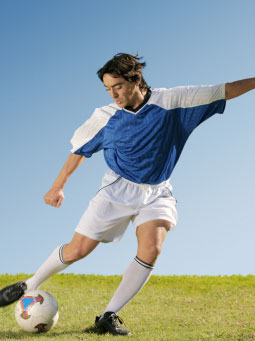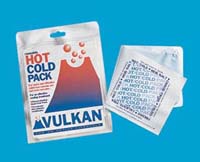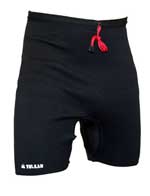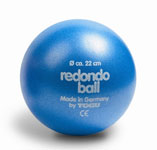Groin Strain & Football
May 13 2008 | Articles

One of the most common injuries in sports, particularly in football, is a groin strain. This type of injury describes a strain on the Adductor muscles located inside the thigh. There are five types of muscles that fall under the Adductor muscle group.
• Adductor Brevis
• Adductor Longus
• Adductor Magnus
• Gracilis
• Pectineus
A groin strain injury normally happens when the muscle is forced to stretch beyond its limitations, resulting to muscle tissue tears. The tear in the muscle is commonly called the strain, and classified into three different degrees, depending on its severity.
• First degree strains normally have little damage to the muscle fibres.
• Second degree strains have more extensive damages on the muscle fibres.
• A third degree strain involves complete damage to the muscle.
How to Identify Groin Strain Injuries
Signs for grade one groin strains do not normally appear until a particular activity is done. Athletes may experience sensations of cramps or tightness, or feelings of pain once muscles are contracted or stretched.
Grade two Groin Strains immediately have sensations of pain, far more painful than those of the grade one injuries. It also produces severe pain on walking. The grade two Groin Strains are usually confirmed by pains, especially when muscles are contracted or stretched. This type of Groin Strain is normally very sore to touch.
Grade three Groin Strains are rare in the adductor muscles. These types keep the athlete from walking without pain and he immediately feels a stabbing pain or burning sensation. For both the grade two and three Groin Strain injuries, a large bruise is normally formed below the injured area after a few days. The bruise is generally caused by bleeding of the damaged tissues.
As for those suffering from complete ruptures, an orthopaedic doctor is generally required. The damaged muscles are repaired surgically and normally, rehabilitation afterwards takes about three long months.
Treating Groin Strains
When you are experiencing Groin Strains, try to consider the things below.
• Consult professional sport injury experts
• to relieve pain and reduce bleeding, try applying ice packs on the damaged area.
Immediate treatment for any type of muscle injury is to commence three practical yet helpful methods: rest, ice, and compression. Apply ice packs on the damaged area for twenty minutes, if possible, every couple of hours.
Ice packs are proven to effectively reduce bleeding and relieve pain on the damaged tissue. This method eventually helps in reducing the injury rehabilitation time.

View Reusable ice pack
Although a very common sense approach, resting is sometimes ignored, especially by competitive footballers. Generally, footballers suffering from grade one Groin Strains should not have any sporting activities for three weeks; and about four to six weeks for those that have grade two Groin Strains
Preventing Groin Strain
• To keep muscle temperature, wear compression shorts
• Before some sporting activities, do some warm up exercises
• After doing sporting activities, do some cool down exercises
• For core strengthening exercises, use a Swiss Ball
• Use energy bars and gels to replenish your carbohydrates during sporting activities
Football Rescue Recommends
Neoprene Thin Warm Pants
![]()
![]()
![]()
![]()
![]() 5 Star Rating
5 Star Rating
Pull cord waist for adjustable fit. Lycra crutch allows for complete freedom of movement. Compression and support for thighs, groin and hamstring injuries.

View Compression and support for groin injuries

Click here to view exercise balls to strengthen groin muscles
